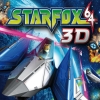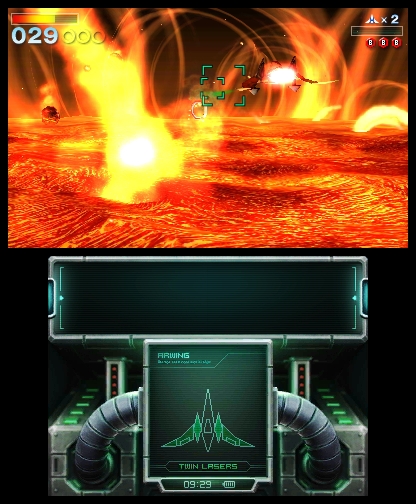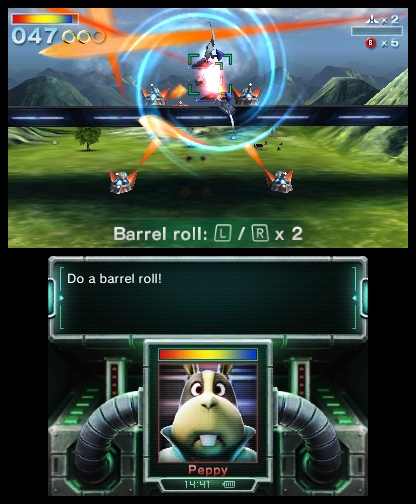Star Fox 64 3D Review
Developer: Nintendo EAD/Q-Games
Publisher: Nintendo
Available on: Nintendo 3DS Only
Way back in 1993, we were getting ourselves pretty damn excited about the UK-developed Super FX chip, a miracle of co-processor wizardry that was put together by London based company Argonaut, and put to use on Nintendo’s first stab at polygon graphics; Star Fox. A thrilling on-rails science fiction shooter, which introduced the now-iconic pilot Fox McCloud and his team of anthropomorphic animal wingmen, Star Fox was loosely based upon Argonaut’s own classic 8-bit title Starglider and went on to spawn numerous sequels across subsequent Nintendo hardware.
With moves to third person adventuring, turn based strategy and farming out programming duties to other developers such as Rare and Namco, it is fair to say that McCloud’s ensuing sequels are something of a mixed bag. Arguably the finest instalment in the franchise was the Nintendo 64 title Star Fox 64 (Released in the UK as Lylat Wars), the first sequel to the original game and a straight up rail shooter which featured a heap of new features that were originally due to be incorporated into a long-abandoned SNES sequel. It recieved considerable acclaim and is much loved by fans to this day, so it came as no surprise when a 3DS remake was announced, à la Ocarina Of Time, to be handled by Nintendo EAD and Q-Games.
To the uninitiated, Q-Games is a developer formed by Dylan Cuthbert, formerly of Argonaut. Interestingly, before Cuthbert left his former employer, he had already developed Star Fox 2 in its entirety, the aforementioned sophomore SNES effort that never saw the light of day. Q also put out the well regarded Star Fox Command which was a hit amongst long term fans when it came out on Nintendo DS in 2006. This presumably puts him in an excellent position to re-imagine Star Fox 64 and bring his considerable expertise to this 3D Fox-fest. But does it satisfy our demand for retro on-rails action, or get shot down in flames by Andross scum?
STORY: If you wanted to make a lazy comparison, then the Star Fox series, with its character-led story involving Fox McCloud attempting to avenge the death of his father and save the universe, is a bit like Star Wars-lite, with more animals.
The crazed good-scientist-gone-bad Andross, who manifests himself as a horrific giant disembodied monkey head, has decided he wants to attempt (once more) to properly merk the peaceful Lylat system that Fox and his buddies call home with the biological weapons he has developed. In addition to his latent megalomaniacal tendencies, this floaty simian bastard is also directly responsible for the death of Fox’s father, along with a double-crossing talking pig who previously fought alongside McCloud Sr.
What this means is that you take control of Fox and his ragtag mercenary posse of bestial co-pilots, with the aim of using your nifty Arwing spacecraft to flush out Andross from his nasty home planet, Venom. Along the way are numerous different destinations in which to engage in winsome space combat, including all of your favourite sci-fi cliches. Underwater world, fire world, asteroid field, etc – all of the gang are present. As you negotiate your way through the Lylat system you will encounter a number of foes, such as the treacherous Pigma and the rival Star Wolf team, a similar band of mercenary pilots who have thrown their lot in with Andross.
GRAPHICS: Like the brilliant remake of Ocarina Of Time, Star Fox 64 3D has been given a beautiful graphical overhaul, that makes an already impressive game look even better, fully dragging it into 2011 with some excellent stereoscopic magic.
The fifteen hugely varied levels look great; the 3D works an absolute treat, and the formerly blocky Arwings and enemy craft have been smoothed out and glint dazzlingly in the light as the nippy action whizzes along, all holding up perfectly with no issues in the framerate department. Particular praise must be levelled at how impressive the water effects look, how huge and intimidating some of the bosses are (the giant skeleton thing is pant-crappingly badass), and how satisfying the explosions are.
SOUND: The musical accompaniment is classic Nintendo stuff. Most of you will be familiar with the Star Fox theme, and the ditties that play out over the numerous stages all create a wonderfully familiar sense of place. What I had forgotten about, however, was how bloody annoying some of the in-game speech is. It goes from one extreme to another; in the excellent introductory tutorial, you are talked through the various controls and such and such by a personable bear/racoon dude, whose soothing gravelly American accent, reminiscent of favourite radio and televisual golf pundit Bob Bubka, I have absolutely no beef with whatsoever.
What I do have a gripe with are the voices of your Star Fox team-mates. Falco in particular will grate on you like sand in the gusset, and is the feathered Jar Jar Binks you will grow to hate, with the amphibious Slippy and buck-toothed partner in crime Peppy irritating to a lesser extreme. The same phrases, cries for help and general whining are repeated ad nauseam, and unfortunately there is no option to turn it off or switch to the less-annoying Japanese speech. That said, the music is ace, as are the typically decent laser and explosion noises.
GAMEPLAY: There are fifteen stages to negotiate, which range from on-rails types where you follow a fixed path through a level, to more open environments where you can fly around a larger area map, usually with a target in mind like destroying an enemy base. The nature of the game means that in order to reach Andross you only have to play through seven of the stages, meaning your path through the Lylat galaxy is a branching one, and the area you fly to next always depends on how you do or whether you meet certain requirements within the preceding stage. Obviously this means that there is significant replay value, as in certain cases you have to meet score criteria or earn medals for the number of enemies wasted in order to unlock a new stage.
The sterling single player mode, which is as playable as remembered from way back in 1997, is backed up by a cool deathmatch mode, where using just one cartridge you can play against up to four chums locally, the 3DS camera allowing you to emblazon a photo of your gurning face onto your Arwing as you take on the role of a zoological Top Gun.
All of this is played with a superb approximation of the original N64 control method, even to the point where Nintendo have allowed you to use the same button mapping as the original controller, albeit with the circle pad replacing the wonderful old N64 analogue stick. Your laser and bomb arsenal, as well as boost and brake for your ship, are on the face buttons, barrel rolls are taken care of with the shoulder buttons. You do have option to use the gyro to control your craft which technically works very well, however unlike Ocarina of time, where you invariably used this control method in far less frantic situations, the speed of Star Fox means that this method is far from ideal, unless you like moving around lots, or have a particularly good rotating office chair. Also, you can forget about turning the 3D slider on if you want to play this way, as for the most part things will just end up a sorry blur.
LONGEVITY: The actual game will only take you about an hour to complete a runthrough, but this does not take into account the branching structure and unlockable nature of the stages, therefore it will take some exploring and a degree of mastery to discover everything on offer. There is a score attack mode and the brilliant dogfighting battles, which can be enjoyed with friends or even against the computer, and that’s about it.
VERDICT: Star Fox 64 was an excellent game, and this is a super overhaul and all-round package, albeit not a particularly features-packed one. Whilst it is hard to see what more Nintendo could have done with it, save for perhaps including a port of the original Star Fox, for example, there is no denying that for a full price purchase, Star Fox 64 3D is lacking in depth and longevity, and is essentially just a straight port of a game originally released before the turn of the century.









